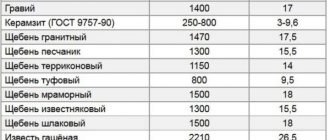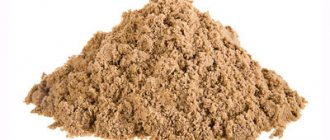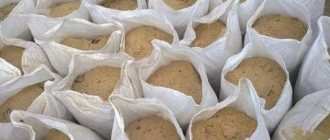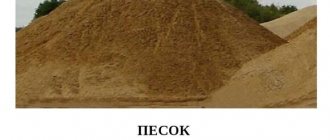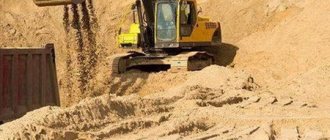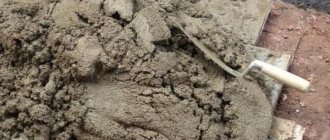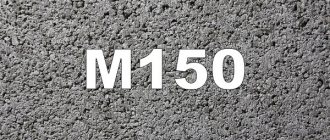Home Useful information How much does 1 cube of construction sand weigh? Calculator
Article rating: 4.9 out of 5 Votes: 13
The weight of bulk materials is taken into account when preparing cement mixtures and concrete solutions. It is influenced by humidity, particle size, origin. Construction sand is obtained by sifting crushed stone, crushing rocks, and during the development of sand and gravel deposits. Since the density of rocks is not the same, the specific gravity of construction sand is also different.
Specific gravity of construction sand
| View | Bulk density, kg/cu.m. m |
| Construction wet compacted | 2540 |
| Construction wet | 1920 |
| Construction rammed | 1680 |
| Building | 1500 |
| Construction loose | 1440 |
| Quartz | 1650 |
| River | 1630 |
| Mountain | 1580 |
| Career | 1500 |
| Ovrazhny | 1400 |
Specific gravity is the ratio of the weight of a material to the volume it occupies. This parameter is necessary at any construction site, since it allows you to select a dump truck for transportation, taking into account its load capacity and body volume. At the same time, it is hygroscopic (absorbs moisture), so its mass changes with increasing air humidity. Bulk material is subject to compaction and loosening under the influence of external factors, which leads to a change in bulk density - the mass of 1 cubic meter. m of sand, taking into account the voids between the particles.
Bulk density of sand
Bulk is the density that sand has immediately after filling without any mechanical or moisture compaction. You can determine it at home. To do this, you need to take a dry measuring vessel, the volume of which has been accurately verified, weigh it, pour sand into it to the top, remove the pile with a flat object without compaction, and weigh the vessel again. If the resulting mass of sand (minus the mass of the vessel) in kilograms is divided by the volume in liters, you obtain the bulk density of sand in kg/dm³, which can easily be converted to kg/t by multiplying the number by 1000. Example. 2 kg/dm³ is 2000kg/m³ (or 2t/m³).
In laboratory conditions, bulk density is determined in a similar way, but using measuring cups and a measuring device of the accuracy regulated by GOST.
Knowledge of bulk density is necessary when ordering sand for work with dosed consumption of material, when purchasing it in volumetric or mass units. Deception of buyers by dishonest sand sellers is often based on fraud with the volume and weight of this material.
The priority area of work is WATER PURIFICATION, which includes: design, selection of equipment and its supply, installation, commissioning and commissioning of water purification plants for both housing and communal services and individual developers (cottages, cottage and holiday villages), for municipal objects and formations, social facilities (schools, hospitals, kindergartens, hotels, cafes, restaurants, etc.), and for various industries:
- for microelectronics with the production of water that meets the quality requirements according to the standards: OST 11.029.003-80; SEMI, ASTM;
- for pharmaceuticals, medicine with the production of water that meets quality requirements according to standards: FS 42-2619-97;
- for thermal power engineering and nuclear power engineering with obtaining water quality determined by the requirements for feed water for feeding heating networks, for power plants with low, medium and high pressure boilers;
- for the chemical and petrochemical industries, electroplating industries with obtaining water quality in the widest range: from ordinary drinking water according to the requirements of SanPiN 2.1.4.1074-01 to ultrapure (deionized);
- for the food industry with obtaining the quality and composition of water that meets the requirements of SaNPiN 2.4.1116-02 for bottling water of the highest and first quality categories; TI-10-5031536-73-10 for the production of beer and soft drinks; TI-10-04-03-09-88 and TI 10-04-03-07-90 for the production of vodka, etc.
- for reverse cooling and air conditioning systems;
At the same time, in the instrumental design of technological processes, we widely use both classical methods of water treatment: pressure filtration, catalytic deferrization, ion exchange, adsorption, aeration and deaeration, decarbonization, reagent treatment (coagulation, flotation, adjustment of the properties and chemical composition of water, etc.) , ultraviolet sterilization, ozonation, dosing oxidants into water, as well as modern membrane water purification technologies, such as: microfiltration, ultrafiltration, nanofiltration, hyperfiltration (reverse osmosis), electrodeionization, which today provide both the production of deionized (ultrapure) water and and have a high degree of environmental friendliness.
The water purification installations (systems) we develop include:
- guaranteed and stable quality of purified water that meets the Customer’s requirements, due to computer modeling of the process and an individual approach to any project using all the capabilities of the equipment;
- cascade cleaning system, the principle of which is that each previous technological cleaning unit “protects” the next one;
- modular design of water treatment plants, the principle of which is that there is always the possibility of modernizing an installation or a separate unit (cascade) with increasing its productivity;
- reliability of operation of the equipment included in the water treatment plant is ensured by high quality standards of equipment supplied from leading domestic and global manufacturers;
- simplicity in management and maintenance of water treatment systems and its individual units due to the choice at the design stage of the type of control unit by the Customer for both the installation as a whole and its individual components.
AIR AND INDERENT GASES PURIFICATION is the second priority area of activity of our company. Includes: design, selection of equipment and its supply, installation, commissioning and commissioning of installations (systems) for cleaning compressed air or inert gases for the following industries:
- for microelectronics;
- for pharmaceuticals, medicine;
- for thermal power engineering and nuclear power engineering;
- for the chemical and petrochemical industries;
- for galvanic production;
- for the food industry.
When implementing projects for the production and purification of compressed air, we use both domestic and foreign developments, such as BOGE, SMC, Pneumax SpA, CAMOZZI, etc. The special pride of our company is devices for purifying air from vapors gasoline and diesel fuel of the FB (FD)* and FB (FD) *M series.
Secondary indicators
Additional criteria for the quality and strength of the material include:
- Thermal conductivity. The average value is 0.30 W/m°C. The thermal insulation properties of the material largely depend on the shape of sand grains and fractional composition. The less space between the granules, the greater the thermal conductivity coefficient.
- Melting temperature. Quartz sand tolerates temperatures up to 1050 degrees Celsius, so it is suitable for all types of construction work.
- Volume weight. In a loose state, the figure is 1,500 kg/m3.
- Abrasion and crushability. To determine these characteristics, sand grains are poured into a rotating metal circle. Tests are also carried out by scratching the substance using a standard or by pressing.
Find out more information about the characteristics of quartz sand from specialists.
5 / 5 ( 1 vote)
How much does 1 cubic meter of sand weigh?
Home comfort How to calculate the volume of concrete - formula. How much does 1 cube of concrete weigh? How many cubes of concrete are needed for the foundation?
Concrete is an artificially made stone building material. You can make it yourself or buy ready-made reinforced concrete products from a factory, which reduces construction time.
Business How to calculate how many boards are in a cube?
Before we begin to calculate the cubic capacity of different types of boards and answer the question: “How many boards are in a cube?” — we should consider what the concept of “cubic meter of lumber” means, and what the pre...
Home comfort How to calculate how many square meters of building material are in one cube
During construction, the question often arises about how many square meters are in one cubic meter. This applies to many materials, which according to their parameters have three indicators: length, width, height. To obtain…
Home comfort How to calculate how many cubes are in a ton of asphalt?
Today, the transport network is one of the indicators of the level of economic development. High-quality road surfaces help increase freight traffic and reduce transportation costs, while increasing urban infrastructure…
Home comfort How to calculate how many tons of crushed stone in a cube
To carry out various construction works, even on a small scale, it is necessary to first calculate the amount of material required. Counting piece building materials will not be difficult. A little …
Characteristics
There are several types of medium-sized sand. For example, there is a classification that is based on the method of obtaining it. Depending on this characteristic, natural sand can be natural, crushed, fractionated, quarry, alluvial, sea. This type of medium-grained material is called such because of the size of the sand grains (fractions), the value of which is in the range of 2-2.5 mm (this data is recorded in the official and generally accepted GOST document).
Experts also distinguish classes I and II of medium-sized natural material. The class of the material depends on the content of grains of different sizes.
So, for medium sand the residual amount should be about 30-40% of the total volume.
Medium-grained sand (like other varieties of similar material) has distinctive features and unique characteristics. So, for a material of this type, the following properties are of great importance:
- maximum bulk density (in the range of 1500-1700 kg/m3);
- specific gravity (indicator 2.55-2.65 kg/m3);
- volumetric mass (characterizes the material in its natural state, 1.5-1.8 kg per m3);
- deformation modulus (can be 30, 40 or 50);
- filtration coefficient;
- elasticity (120 MPa);
- compaction index (is of utmost importance during repair and installation tasks, is about 0.95-0.98);
- angle of internal friction;
- porosity (sand can be dense, loose or of medium density);
- clutch;
- design resistance;
- size model, grain composition;
- presence of undesirable impurities and others.
The individual characteristics and properties of this group of sand, such as medium-grained material, described above, suggest its use not for all repair, construction and installation work.
In addition, it is important to consider other characteristics of medium sand:
- environmental friendliness (thanks to this indicator, sand can be used without fear for your health, as well as for the health of those people who will use products made from sand);
- fluidity, which helps fill voids (which is why the material is in demand in the construction industry);
- absence of unpleasant odors (the material can be used even inside residential premises);
- the material does not burn (this property increases the safety of using the material);
- durability (products in the manufacturing process of which medium-grained sand was used will last a long period);
- not affected by fungi, does not rot;
- strength and reliability.
Calculator
Submit your application
The weight of river sand depends on the origin, type of material, and particle size. The sand is sieved, dividing into fine-, medium-, and coarse-grained. It also differs in color: it can be brownish, gray, yellow. The shade is influenced by the location of extraction and the type of clay in the surrounding area, as well as the composition of minerals. The building material is hygroscopic and absorbs moisture in large volumes, so air humidity affects the mass. Therefore, the specific gravity of different types of river sand differs significantly.
